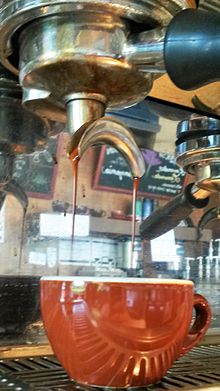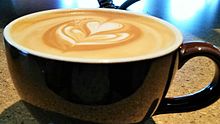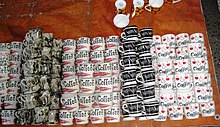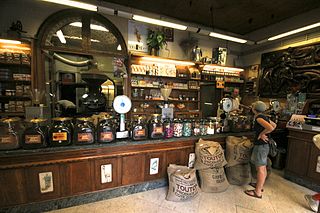
Italians are well known for their special attention to the preparation, the selection of the blends, and the use of accessories when creating many types of coffees. Many of the types of coffee preparation known today also have their roots here. The main coffee port in Italy is Trieste where there is also a lot of coffee processing industry. Italian coffee consumption, often espresso, is highest in the city of Trieste, with an average of 1500 cups of coffee per person per year. That is about twice as much as is usually drunk in Italy.

Polystyrene (PS) is a synthetic polymer made from monomers of the aromatic hydrocarbon styrene. Polystyrene can be solid or foamed. General-purpose polystyrene is clear, hard, and brittle. It is an inexpensive resin per unit weight. It is a poor barrier to air and water vapor and has a relatively low melting point. Polystyrene is one of the most widely used plastics, with the scale of its production being several million tonnes per year. Polystyrene is naturally transparent, but can be colored with colorants. Uses include protective packaging, containers, lids, bottles, trays, tumblers, disposable cutlery, in the making of models, and as an alternative material for phonograph records.
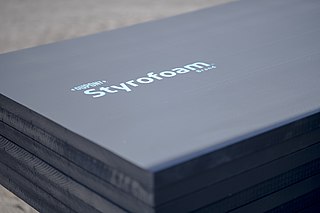
Styrofoam is a trademarked brand of closed-cell extruded polystyrene foam (XPS), manufactured to provide continuous building insulation board used in walls, roofs, and foundations as thermal insulation and as a water barrier. This material is light blue in color and is owned and manufactured by DuPont. DuPont also has produced a line of green and white foam shapes for use in crafts and floral arrangements.

A teapot is a vessel used for steeping tea leaves or a herbal mix in boiling or near-boiling water, and for serving the resulting infusion which is called tea. It is one of the core components of teaware. Dry tea is available either in tea bags or as loose tea, in which case a tea infuser or tea strainer may be of some assistance, either to hold the leaves as they steep or to catch the leaves inside the teapot when the tea is poured. Teapots usually have an opening with a lid at their top, where the dry tea and hot water are added, a handle for holding by hand and a spout through which the tea is served. Some teapots have a strainer built-in on the inner edge of the spout. A small air hole in the lid is often created to stop the spout from dripping and splashing when tea is poured. In modern times, a thermally insulating cover called a tea cosy may be used to enhance the steeping process or to prevent the contents of the teapot from cooling too rapidly.

A mug is a type of cup typically used for drinking hot drinks, such as coffee, hot chocolate, or tea. Mugs usually have handles and hold a larger amount of fluid than other types of cups. Typically, a mug holds approximately 240–350 ml of liquid. A mug is a less formal style of drink container and is not usually used in formal place settings, where a teacup or coffee cup is preferred. Shaving mugs are used to assist in wet shaving.

A drinking straw is a utensil that is intended to carry the contents of a beverage to one's mouth. Disposable straws are commonly made from plastics. However, environmental concerns related to plastic pollution and new regulation have led to rise in reusable and biodegradable straws. Following a rise in regulation and public concern, some companies have even voluntarily banned or reduced the number of plastic straws used. Alternative straws are often made of reusable materials like silicone or metal or alternative disposable and biodegradable materials like paper, cardboard, pasta, or bamboo.

A cooler, portable ice chest, ice box, cool box, chilly bin, or esky (Australia) is an insulated box used to keep food or drink cool.

A disposable is a product designed for a single use after which it is recycled or is disposed as solid waste. The term is also sometimes used for products that may last several months to distinguish from similar products that last indefinitely. The word "disposables" is not to be confused with the word "consumables", which is widely used in the mechanical world. For example, welders consider welding rods, tips, nozzles, gas, etc. to be "consumables", as they last only a certain amount of time before needing to be replaced. Consumables are needed for a process to take place, such as inks for printing and welding rods for welding, while disposable products are items that can be discarded after they become damaged or are no longer useful.

A paper cup is a disposable cup made out of paper and often lined or coated with plastic or wax to prevent liquid from leaking out or soaking through the paper. It may be made of recycled paper.
Keurig is a beverage brewing system for home and commercial use. The American company Keurig Dr Pepper manufactures the machines. The main Keurig products are K-Cup pods, which are single-serve coffee containers; other beverage pods; and the proprietary machines that use these pods to make beverages.

A plastic cup is a cup made out of plastic, commonly used as a container to hold beverages. Some are reusable while others are intended for a single use followed by recycling or disposal.

A single-serve coffee container is a container filled with coffee grounds, used in coffee brewing to prepare only enough coffee for a single portion. Single-serve coffee containers come in various formats and materials, often either as hard and soft pods or pads made of filter paper, or hard aluminium and plastic capsules.
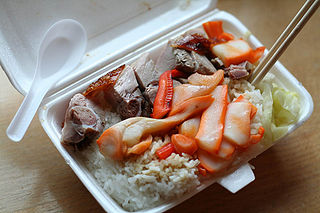
A foam food container is a form of disposable food packaging for various foods and beverages, such as processed instant noodles, raw meat from supermarkets, ice cream from ice cream parlors, cooked food from delicatessens or food stalls, or beverages like "coffee to go". They are also commonly used to serve takeout food from restaurants, and are also available by request for diners who wish to take home the remainder of their meal. The foam is a good thermal insulator, making the container easy to carry as well as keeping the food at the temperature it had when filled into the container, whether hot or cold.
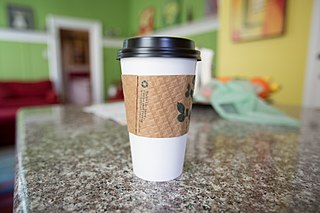
Coffee cup sleeves, also known as coffee sleeves, are roughly cylindrical sleeves that fit tightly over handle-less paper coffee cups to insulate the drinker's hands from hot coffee. Coffee sleeves are typically made of textured paperboard, but can be found made of other materials. Coffee sleeves allow coffee houses, fast food restaurants, and other vendors to avoid double-cupping, the practice of using two nested paper cups for a single hot beverage. Some paper cup holders carry advertisements.

Disposable food packaging comprises disposable products often found in fast-food restaurants, take-out restaurants and catering establishments. Typical products are foam food containers, plates, bowls, cups, utensils, doilies and tray papers. These products can be made from a number of materials including plastics, paper, bioresins, wood and bamboo.

A cup is an open-top container used to hold liquids for pouring or drinking. Although mainly used for drinking, it also can be used to store solids for pouring. Cups may be made of glass, metal, china, pottery, wood, stone, bone, polystyrene, plastic, aluminium or other materials, and are usually fixed with stem, handles, or other adornments, though a beaker has no handle or stem. Cups are used for quenching thirst across a wide range of cultures and social classes, and different styles of cups may be used for different liquids or in different situations. Cups of different styles may be used for different types of liquids or other foodstuffs, in different situations, or for decoration.

A disposable cup is a type of tableware and disposable food packaging. Disposable cup types include paper cups, plastic cups and foam cups. Expanded polystyrene is used to manufacture foam cups, and polypropylene is used to manufacture plastic cups.

Disposable tableware includes all disposable tableware like

In the late 20th and early 21st century, there has been a global movement towards the phase-out of polystyrene foam as a single use plastic (SUP). Early bans of polystyrene foam intended to eliminate ozone-depleting chlorofluorocarbons (CFCs), formerly a major component.
